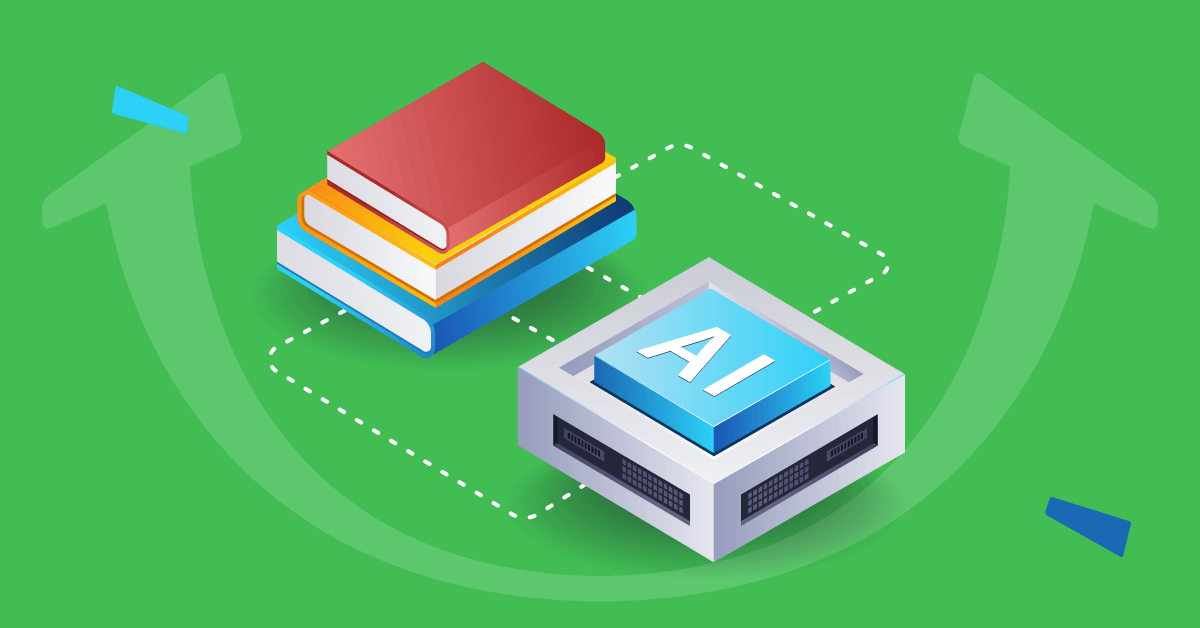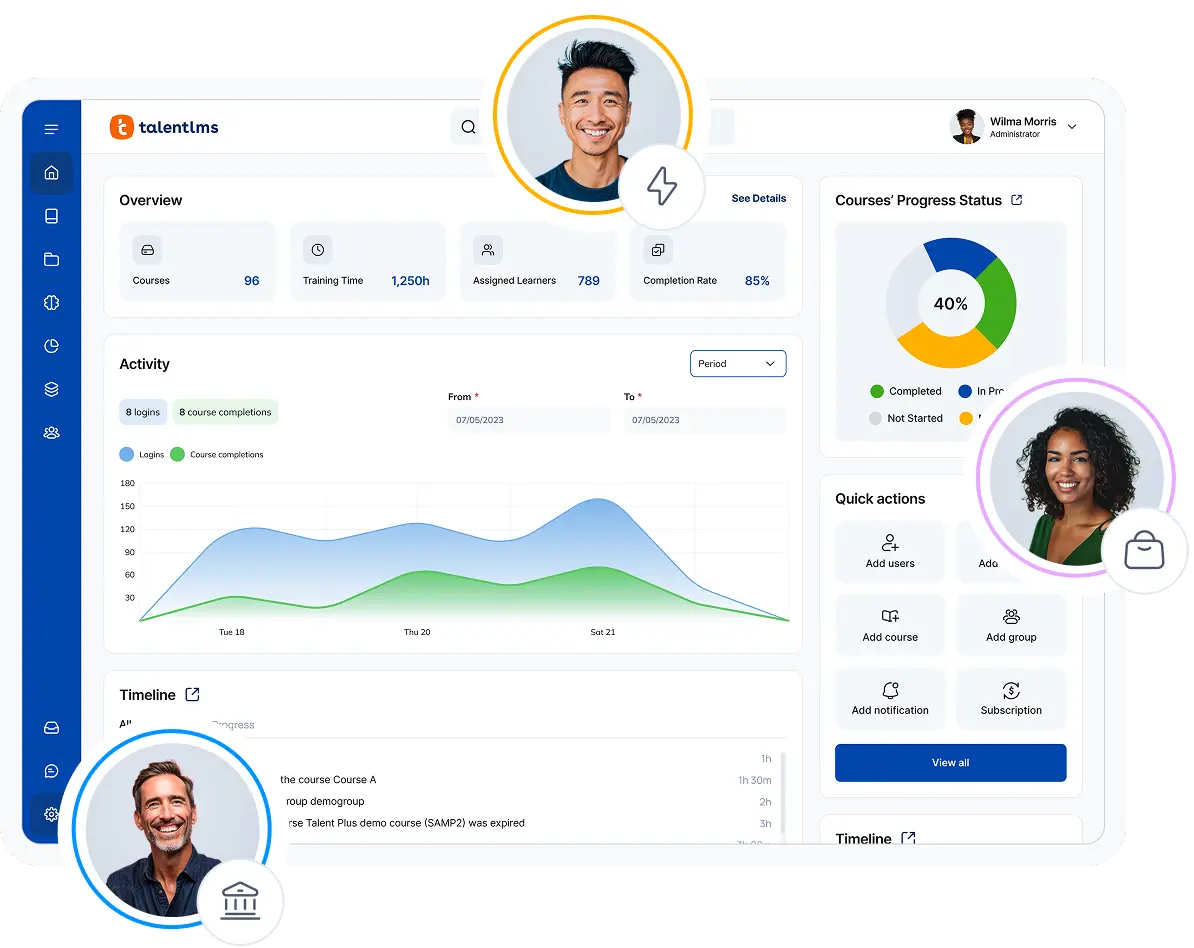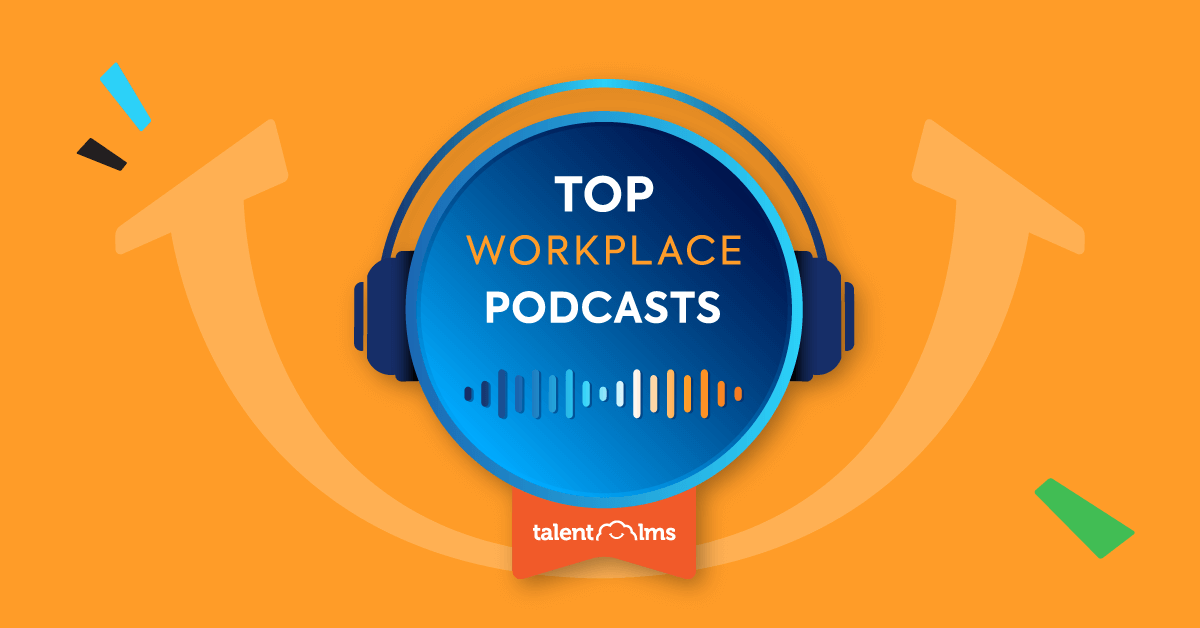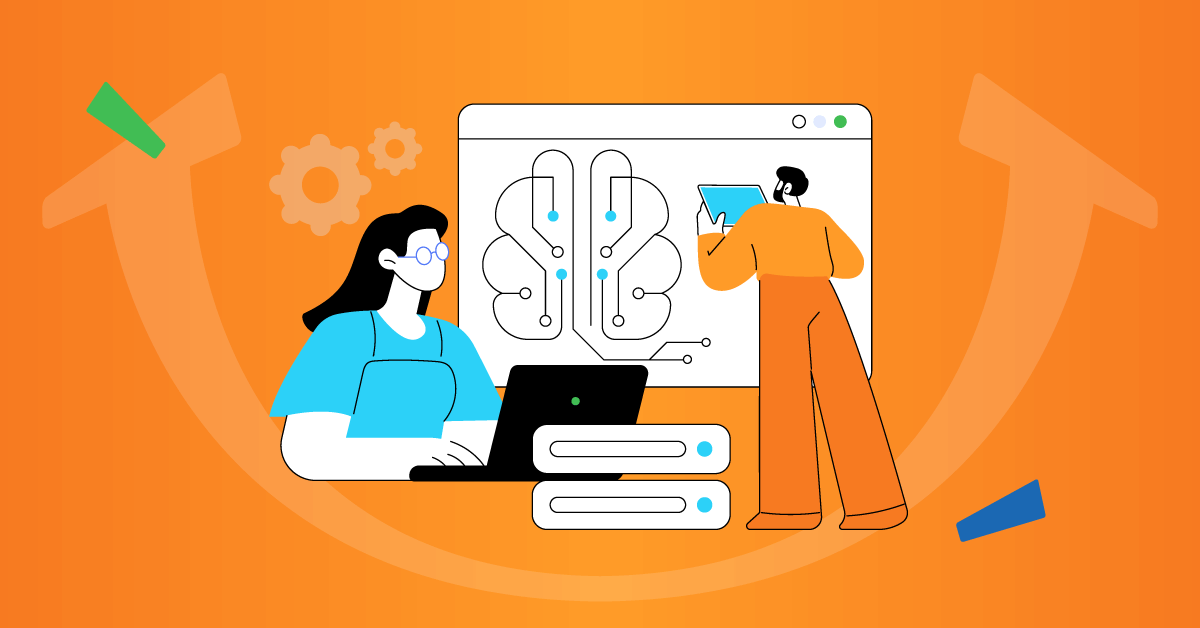Artificial Intelligence (AI) is here to stay. In fact, it transforms various industries. And learning and development is no exception. But is this change for the better?
AI’s sudden incorporation into learning and development processes is reshaping how organizations train their employees, boosting the efficiency, personalization, and impact of the learning experience. It also streamlines tasks for instructors, automating processes and reducing time spent on mundane activities. It’s a win-win scenario benefiting learners, L&D professionals, and the entire organization.
You should see AI as not a passing trend but a core shift in how people approach learning, realizing tools and methods that were previously a dream.

7 Use cases of AI in L&D
AI in L&D revolutionizes employee training, as it offers personalized learning experiences that fit individual needs, ensuring maximum engagement and learner retention.
Imagine AI as a super-intelligent mentor. It evolves with you, providing instant feedback and adapting to your learning pace. In brief, AI makes traditional training a dynamic and interactive experience.
Season two of the TalentLMS podcast series begins with AI strategist and eLearning expert Stella Lee. In episode 12, Generative AI in L&D and the evolution of eLearning, she discusses the process of choosing AI tools, upskilling a workforce in AI, and ensuring everyone in an organization is involved in creating ethical AI policies.
Lee says “AI tools must be integrated into every step of the ADDIE model (Analysis, Design, Development, Implementation, and Evaluation.) These tools are exceptional for analyzing learner data, ideation in design, developing content, and even evaluating learning outcomes. All of which makes the ID process way more efficient and data-driven.”
Let’s see how AI can be used in L&D.
1. Content authoring
One of the most significant applications of AI in learning and development is content authoring.
Imagine the effort involved in creating educational content—it’s time-consuming and resource-intensive. AI steps in to analyze vast data sets, swiftly generating and curating content that’s always relevant and up-to-date. This way, instructors can offer learners the latest information—particularly useful in fast-evolving fields like technology and medicine. Plus, AI tailors content to different learning styles and preferences, making training more engaging, effective, and inclusive.
Here’s an example: AI tools can generate quizzes, summaries, even entire lessons based on input from Subject Matter Experts (SMEs). This automated content creation reduces the time trainers spend developing materials, allowing them to focus more on interacting with learners and refining their learning strategy.
2. Personalized learning paths
Personalization is one more powerful feature of artificial intelligence in learning and development.
In traditional training, the cookie-cutter approach often misses the mark, failing to address the diverse learning preferences and styles of individuals. This can lead to decreased engagement and effectiveness, leaving many learners feeling disconnected and uninspired by the learning process. AI changes this by creating personalized learning paths. In fact, it can recommend specific courses or training materials tailored to individual needs. How? By tracking a learner’s progress, preferences, and performance.
For instance, AI systems identify learner strengths and weaknesses in real time. Then, they adjust the difficulty and type of content accordingly. So, if a learner excels in certain areas, or already has the skills, AI can skip redundant lessons and offer more challenging material. Similarly, if a learner struggles with a particular topic, AI provides additional resources and support to help them better grasp the content.
3. Learner analytics
L&D experts are constantly refining learning processes, and AI turbocharges this effort. Through learner analytics, AI gathers and crunches data on how learners engage with training content. Then it pinpoints what works best, where skills need sharpening, and areas that need improvement in corporate training.
AI swiftly delivers insights into course engagement and other challenges as it tracks various metrics. For example, completion times, quiz scores, and participation levels. This automated analysis replaces repetitive manual processes and ensures training programs are finely tuned for maximum impact and efficiency.
4. Virtual tutors and chatbots
Learner support enhances the overall learning experience. AI-powered virtual tutors and chatbots provide instant assistance by answering questions, offering guidance, and giving feedback.
Virtual tutors simulate 1:1 tutoring sessions, offering explanations and clarifications on demand. They also track learner progress and adapt the training method accordingly. Chatbots handle more direct queries or administrative tasks. For example, scheduling classes or providing course information. This type of immediate support benefits learners who might not have easy access to a human instructor.
5. Automated assessments
Assessments are essential to any learning program. However, they can be time-consuming to administer and grade. AI tools automate this process by offering quick and accurate assessments and feedback. This significantly reduces the workload of L&D experts plus allows learners to have immediate insights into their performance. Thus, they can improve faster.
How do automated assessments work? AI can handle various types of assessments, like multiple-choice quizzes and essay grading. AI algorithms evaluate written responses for grammar, coherence, and relevance. At the same time, they provide detailed feedback that helps learners understand their challenges and improve. The rapid feedback loop boosts effective training as learners can address their weaknesses promptly.
6. Adaptive learning environments
Adaptive learning environments use AI to create dynamic learning experiences based on the learners’ interactions. These environments adjust the difficulty level, presentation style, and type of content in real time.
For example, an adaptive learning platform detects when a learner is disengaged or struggling with a certain topic. It then modifies the content delivery by adding more interactive elements, breaking down the material into smaller parts, or providing examples and assessments. This responsiveness keeps learners engaged and ensures a more effective learning experience.
7. Predictive analytics for learning outcomes
Predictive analytics uses AI to forecast learning outcomes based on historical data. AI analyzes patterns in learner data and predicts which learners risk falling behind and which interventions will be more effective.
Let’s say a learner’s performance data shows a consistent difficulty with specific topics. The AI tool has the ability to predict that the learner might need additional support to complete the training course. It can also proactively suggest additional tutoring sessions,resources, or different learning strategies. This approach helps address issues before they become problems, improving the learner success rates.
Unlocking AI’s potential in L&D
We just saw how AI can revolutionize the L&D process by making the training experience personalized and data-driven. But understanding where it excels and where it falls short is essential for reaping its full potential.
Lee discusses on Generative AI in L&D and the evolution of eLearning that it’s necessary to think carefully to spot potential issues, understand limits, check facts, and verify sources when using AI tools.
Capabilities and benefits of AI in learning and development
Data analysis and skills gap identification
Artificial intelligence in learning and development is powerful for sifting through mountains of data to find patterns and insights. AI tools can highlight where your teams need improvement fast. Or what new skills are becoming essential in your industry. AI can also analyze employee performance data, training outcomes, and more to pinpoint knowledge gaps.
Meaning, L&D professionals can create more targeted corporate learning programs that address real needs. They don’t need to guess or follow generic trends anymore.
Course design and development
AI helps in generating ideas and training content. For instance, if an instructor is stuck on how to start a new training module, AI can suggest titles, activities, and scenarios for immersive learning. Think of AI as a brainstorming partner available 24/7. Plus, AI tools can draft learning objectives, create quizzes, and offer feedback, making the development process faster and less tedious.
Lee mentions “I’ve seen platforms that help you write learning objectives. I’ve seen AI tools that suggest activities or suggest different [learning] scenarios.”
Personalization and learner engagement
One of the benefits of using AI in learning and development is its ability to personalize learning. It tailors content to fit individual needs—progress, preferences, and career goals. So, employees get relevant training which keeps them more engaged. AI can recommend additional resources, suggest the next steps in a learning path, and adjust the difficulty level based on the learner’s performance.
Efficiency and productivity
AI is known for taking over repetitive tasks, freeing up L&D experts to focus on other aspects of their job. For instance, they no longer need to spend hours creating course outlines. AI can handle such tasks in minutes. Thus, L&D teams can spend time on activities that require human touch, like mentoring, coaching, or developing innovative training methods. The process becomes more efficient and less burdensome.
Lee comments “Even if it’s not a great start, it gives you a start. And then by having a few paragraphs of that, I can start editing and playing and moving and cutting and pasting. And then next thing I know, I’m like, okay, I’ve actually turned this okay output into something that’s better.”
Measurement and evaluation
Evaluating how effective the training programs are is a rather complex process. AI simplifies such processes as it tracks usage metrics. For example, how many employees participate in a training module and how often. Then, it analyzes this data to give insights into what’s working and what’s not. If a course has low engagement, AI identifies if the issue is with the content, the delivery method, or something else. This way, L&D professionals can make data-driven decisions to improve the training programs.
Limitations and challenges of AI in L&D
Quality and accuracy of AI output
AI is amazing at generating content. But it’s not perfect. AI outputs need human oversight to ensure they are accurate and relevant. For example, an AI tool might suggest outdated or incorrect information because it takes data from the internet. Not everything is reliable there. So, instructors and L&D professionals must review, evaluate, and refine AI-generated content to maintain a high standard.
Lee discusses how AI generates its responses based on the information it uses. She warns against spreading myths, like the misconception about learning styles that’s widespread online, even on university websites. Then, she explores how AI can pick up and repeat such inaccuracies.
Ethical concerns
Issues like data privacy, algorithm biases, and environmental impact are present when implementing AI in learning and development. AI systems can reinforce biases from their training data, leading to unfair or unethical results. Plus, the environmental cost of running large AI models is significant as it requires largeamounts of energy and water. Companies must address such ethical concerns with robust governance and transparency in their AI practices.
Cultural and contextual fit
L&D experts want AI to be effective. To achieve this, it needs to fit within the organization’s culture and context. This means understanding the current tech infrastructure, how ready the workforce is, and whether there are any specific needs in each department. AI tools should be integrated considering each organization’s unique characteristics and needs thoroughly. What works in one company might not work in another. A one-size-fits-all approach won’t be effective.
Dependency and misuse
L&D professionals shouldn’t over-rely on AI tools without using their critical thinking or creativity skills. Yes, AI can assist with many tasks, but it’s important not to use it as a crutch. Using AI just because it’s a trend, without clear business needs, leads to ineffective solutions. L&D teams must ensure AI is great for solving particular problems but not for replacing humans.
Lee advises, “You want to start from, like, what does your business need? Is this creating new opportunities for you by implementing an AI tool? Is this addressing specific pain points that you’re experiencing? Is it solving problems for you?”
Human element in L&D
AI can’t replace the human touch. The expertise of L&D professionals in designing and delivering training programs can’t be replicated. AI supports their work, but creativity, empathy, and critical thinking are uniquely human traits essential for effective learning experiences. L&D experts should use AI as a tool, not as a substitute, and keep their role in guiding and shaping the learning journey.
Implementation strategies for AI in learning and development
After exploring the benefits and challenges of using AI in L&D, organizations should know the practical steps to integrate it effectively.
TalentLibrary – Skills that matter, courses that deliver
With TalentLibrary, you set the foundation for a strong, aligned workforce—soft skills, compliance, and workplace essentials, from day one (and beyond).
Here’s what you need to know based on AI’s capabilities and limitations:
- Assess your organization’s current state: Explore and understand your organization’s current standing. Evaluate the existing technology, your team’s skill levels, and the organization’s specific needs.
- Define clear goals: Determine what you want to achieve with AI. Is it course creation, learning experience personalization, or improvement of data analysis? Have clear, specific goals to guide the AI implementation that will also help measure its success.
- Build a supportive culture: Foster a culture that supports innovation and new tech adoption. This includes addressing any fears and misconceptions about AI. To achieve that, provide training to improve AI literacy among employees. Lee notes, “Understanding the culture and the context you’re implementing this tool in, not just about countries, but also subcultures within industries and even within departments, is crucial.”
- Select the right tools: There are thousands of AI tools available, and choosing the right one might feel overwhelming. Before starting with the tools, clearly define the business needs. Then look for AI solutions that address these requirements. Also, consider factors like use, scalability, and integration capabilities with your existing systems. “Start with what you need, not just what looks good,” Lee advises.
- Ensure ethical and responsible use: Conduct regular audits to maintain transparency about how AI tools are used. Also, ensure that AI outputs are reviewed by humans to prevent biases and errors.
- Monitor and evaluate AI implementation: Does AI meet your goals? Use quantitative (adoption rates, user engagement, etc.) and qualitative feedback (user satisfaction, impact on learning outcomes, etc.) to assess effectiveness. Then, adjust your strategies based on these insights to continuously improve AI integration. “Always advocate mixed-method measurements, so not just quantitative but also qualitative to get a fuller picture,” says Lee.
Embracing the future AI in learning
AI is transforming the L&D field with personalized experiences, real-time analytics, and automation. It may not yet excel in developing soft skills, but it takes routine tasks out of instructors’ hands. Which allows them to inspire and guide learners more effectively.
Embracing AI in learning and development means using AI technology to boost training programs, unlock peoples’ potential, and drive continuous improvement. Organizations adopting AI-driven solutions lead innovation and equip their teams with the tools they need to succeed in an ever-evolving landscape.
The future of learning is here. And it’s powered by AI. But directed by humans.





